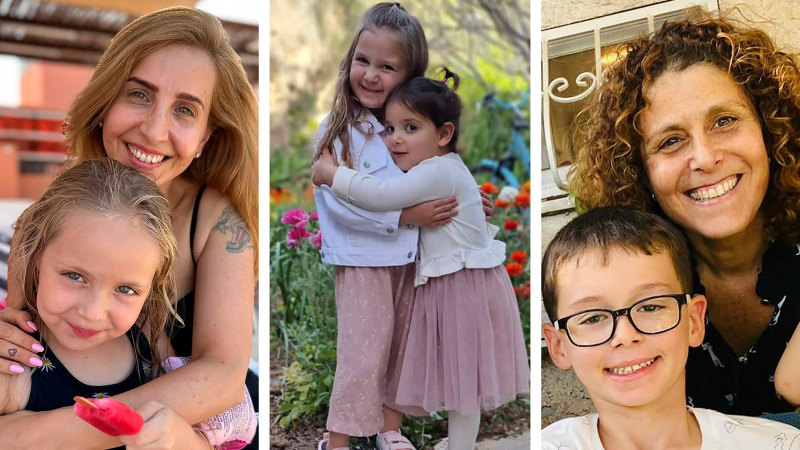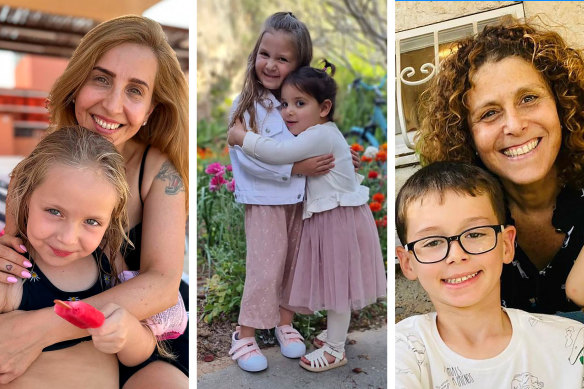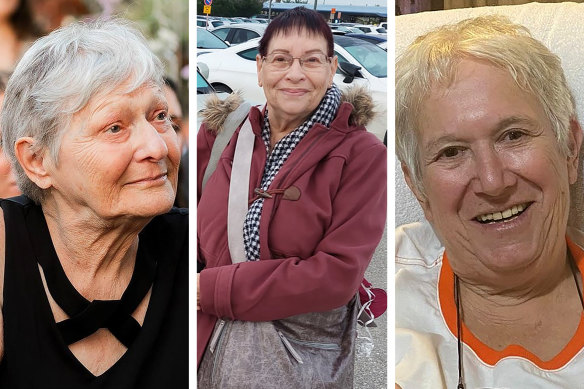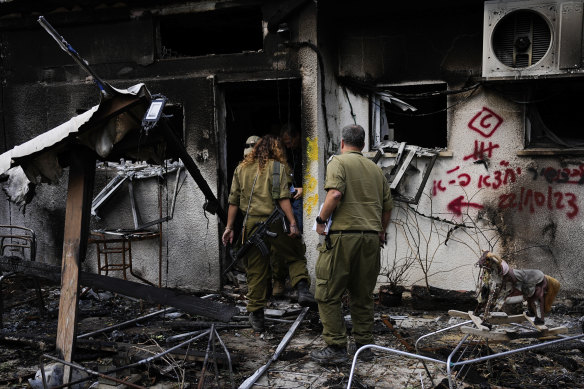Save articles for later
Add articles to your saved list and come back to them any time.
Eilat, Israel: All but one of the 13 Israeli hostages released on the first day of the Israel-Hamas truce were abducted from Kibbutz Nir Oz, a village close to the Gaza Strip border from which Hamas militants took more than 70 people on October 7.
Family members said they were thankful that 12 hostages taken from the kibbutz had been returned home to Israel, but that was only “a drop in the bucket”, according to Larry Butler, 73, a Nir Oz resident who survived the attack. Of the estimated 215 hostages who remain in Gaza, roughly 30 per cent are from Nir Oz.
Undated photos of some of the released hostages, from left: Daniel Aloni and her daughter Emilia; sisters Aviv, right, and Raz Katz Asher; Keren Munder and her son Ohad.
Per capita, Nir Oz is the Israeli village most affected by the devastating attack. That day, roughly 100 Nir Oz residents were killed or abducted – a quarter of the village’s population.
On Saturday (AEDT), the survivors felt some sense of salvation as 12 of their neighbours and relatives – ranging from Yaffa Adar, 85; to Aviv Asher, 2 – were driven to safety by the Red Cross through Egypt to Israel.
“Is that my grandmother?” a young girl cried out after residents identified Margalit Moses, 78, their neighbour from Nir Oz, waving from a Red Cross vehicle.
Released: Yaffa Adar, Channa Peri and Margalit Moses.
But that elation was tempered by a wider feeling of loss.
“There are kids here without parents, parents without kids, and grandparents with grandchildren but no parents,” Butler said.
“See the baby over there?” he said, pointing to a woman with a newborn cradled in her arms. “The husband is in Gaza.”
The village was founded in 1955 as a collective farm whose members pooled their resources and earnings.
Its surviving residents describe their hometown as a left-leaning community, dominated by people who hoped for peace with the Palestinians across the border in Gaza, even as most Israelis lost hope in a negotiated peace settlement.
Israeli soldiers inspect houses destroyed by Hamas militants Kibbutz Nir Oz, southern Israel, last week.Credit: AP
Butler, a Philadelphia native who fought in Vietnam as a US Marine, moved to Nir Oz in 1974 because the community – some of them soldiers turned peace activists – embraced him at a time when Americans turned their back on veterans.
But after the October 7 attack, Butler said his commitment to peace had been shaken. Thirty of his friends were killed and 60 were abducted, he said.
“I trusted them,” Butler said about his Palestinian neighbours. “I was completely wrong,” he added.
After much of the village was destroyed on October 7, most of the survivors moved en masse to a hotel in Eilat, a resort city on the Red Sea. The mood in the hotel swings rapidly between normality to grief.
Earlier this week, packs of Nir Oz kids ran around barefoot in the hotel lobby, seemingly oblivious to the surrounding trauma. Suddenly one boy, about 10 years old, paused his play. “What’s that? I’m hearing shooting,” he said, imagining a semi-automatic weapon only he could hear.
On Thursday evening, when uncertainty about the impending hostage deal was at its peak, Idan Cunio, 8, came up to his mother, Paula Cunio, 38, to announce that he heard on the news that his twin cousins were going to be released.
“He’s just saying what he wants to be true,” Cunio said.
The Cunio family has four family members still in captivity: David Cunio, 33; his partner Sharon Alony Cunio, 44; and their twins Emma and Yuli.
Sharon’s sister, Danielle Alony, 44, and her daughter Amelia, 5, were set free on Saturday (AEDT).
Irit Lahav, 57, who has spent most of her life in Nir Oz, said that being together in the hotel has brought the community together. “We already were like a family,” she said. “But now it’s more like a hugging family.”
However, residents were recently warned that their time in Eilat was coming to a close.
In mid-December, they will be moved to an apartment complex in Kiryat Gat, a small, uncelebrated city in central Israel, for a year. This will jeopardise the communal fabric the kibbutz has worked so hard to maintain, residents said.
Terms of the Israel-Hamas ceasefire
- All fighting in Gaza halts for four days.
- Hamas will release 50 women and children held as hostages.
- In exchange, Israel will release 150 Palestinian women and children from jail.
- The truce deal will allow hundreds of trucks of humanitarian, medical and fuel aid to enter Gaza.
- Israel to extend truce by an extra day for every additional 10 hostages released by Hamas.
“Who will you meet, just your neighbours in the apartment building?” Lahav asked.
In Kiryat Gat, Cunio plans to devote her time to figuring out what’s next. “We’re starting from scratch,” she said. “The life we had before is over.”
The community will be saving rooms for the hostages, but until they are all released, Cunio does not know how they will fit into the future of the kibbutz.
One thing is for certain, Cunio said: she and many other survivors will not be going back to the kibbutz. “There’s nowhere to return,” she said.
This article originally appeared in The New York Times.
More coverage of the Hamas-Israel conflict
- Hamas had bigger plans on October 7: Intelligence about Hamas’ motivations reveals an intention to strike a blow of historic proportions and provoke an overwhelming Israeli response.
- Escape from chaos: An Australian father faced a heartbreaking dilemma – whether to flee Gaza to his children, or stay with his wife.
- Open letters: Mass resignations, boardroom turmoil and angry donors are some of the ways the Israel-Hamas war is filtering down into Australia’s high-powered arts world.
- Gaza’s youth: One of the cruellest ironies of war is that they are never started by children, yet it is children who suffer the most.
Get a note directly from our foreign correspondents on what’s making headlines around the world. Sign up for our weekly What in the World newsletter.
Most Viewed in World
From our partners
Source: Read Full Article





